In this note, we are going to learn about different types of potentiometers or pots. Welcome to Poly Notes Hub, a leading destination for engineering notes for diploma and degree engineering students.
Author Name: Arun Paul.
What is a Potentiometer?
An electrical component with three terminals that functions as a variable resistor is called a potentiometer. By manually varying the resistance, it is used to modify the voltage levels in a circuit.
How a Potentiometer Works?
The wiper shifts its location on the resistive track when you move it, either by rotating or sliding it. This modifies the output voltage by altering the resistance between the wiper and the ends. It frequently controls brightness, loudness, and other analog parameters by acting as a voltage divider.
Applications of Potentiometer
- Use to control voltage in radio and speakers as well.
- Use to control brightness of lights.
- Use to control the speed of motor or Fans.
- Use to settings timers and values in many appliances.
- Use to control other electronic appliances.
Different Types of Potentiometers or POTs
There are various types of potentiometers that are used in AC as well as DC circuits. But here we have listed 8 types of potentiometers which are frequently used in electrical and electronics circuits –
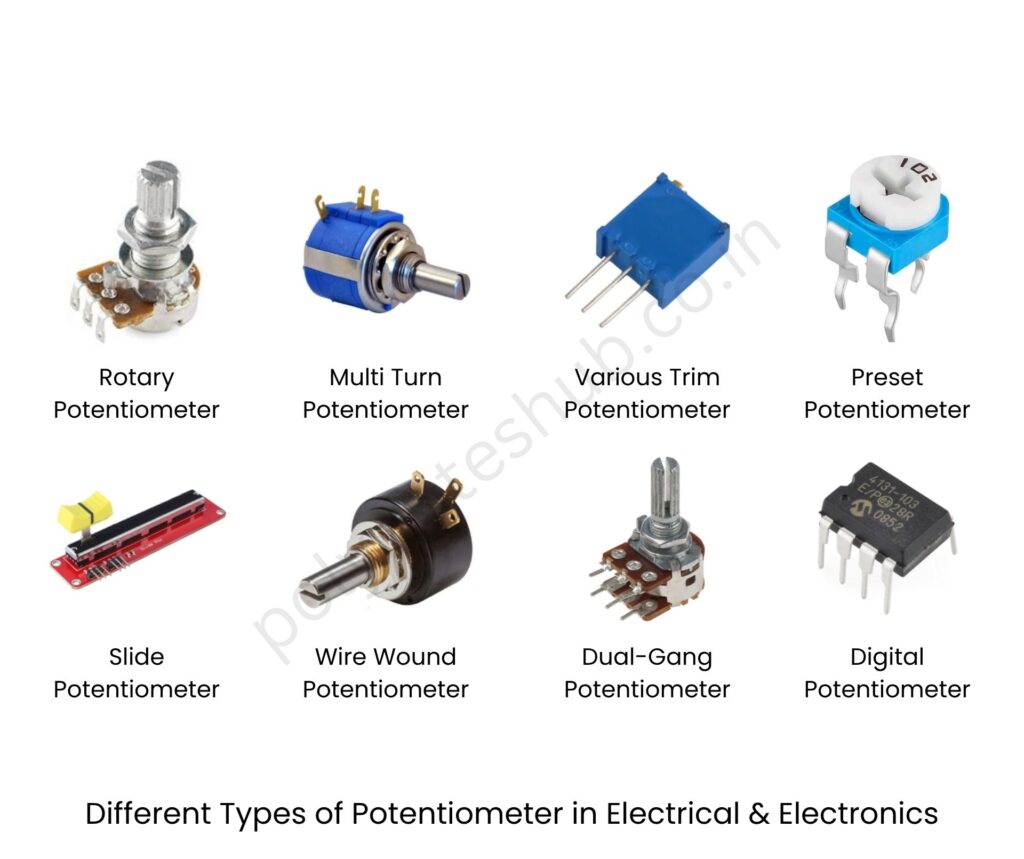
- Rotary Potentiometer
- Multi Turn Potentiometer
- Various Trim Potentiometer or Trimpot
- Preset Potentiometer
- Slide Potentiometer
- Wire Wound Potentiometer
- Dual Gang Potentiometer
- Digital Potentiometer
1. Rotary Potentiometer
One kind of variable resistor is a rotary potentiometer, which alters its resistance in response to shaft rotation or knob turning. Along with a moving contact known as a wiper, it has a circular resistive path. By moving along the route, the wiper alters the resistance between its terminals when the shaft is rotated. Electronic devices can be made to vary things like brightness, speed, or volume by using this change in resistance to regulate the flow of electric current.
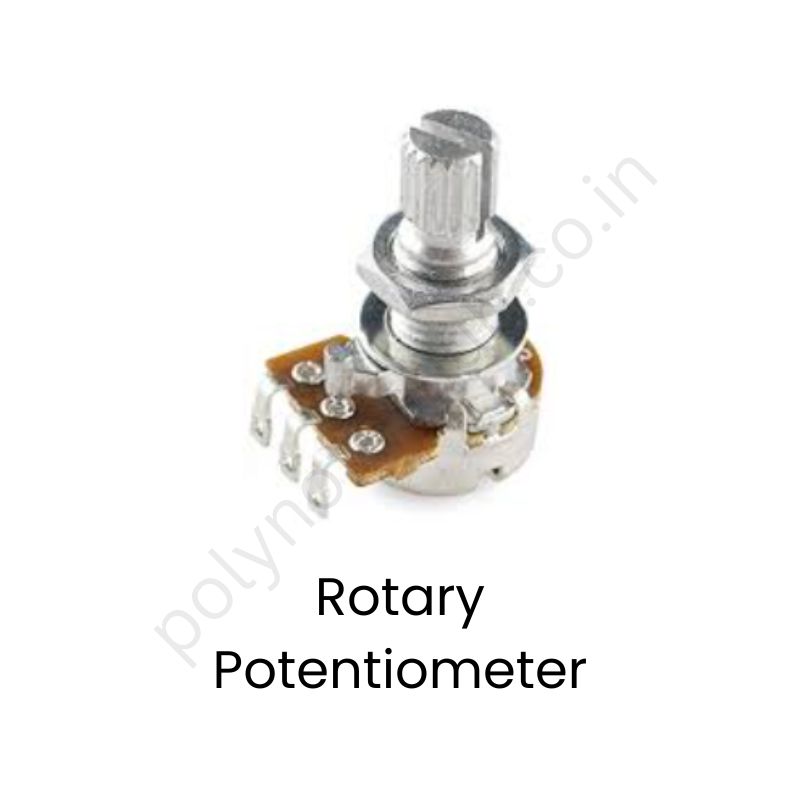
Applications of Rotary Potentiometer
- Volume control in radios and speakers.
- Adjusting brightness and contrast in TV and monitors.
- Controlling speeds of motors and electric fans.
- Used in musical instruments to change tone and settings.
- Used in microwave oven to control time and temperature as well.
2. Multi-Turn Potentiometer
A multi-turn potentiometer is one that allows you to sweep the whole resistance range by rotating the adjustment shaft many times (usually 5, 10, or 20 turns). Unlike a typical potentiometer, which completes its full range in a single turn, this one requires multiple turns to achieve finer control and precision. It is commonly utilized when precise and reliable adjustments are required.
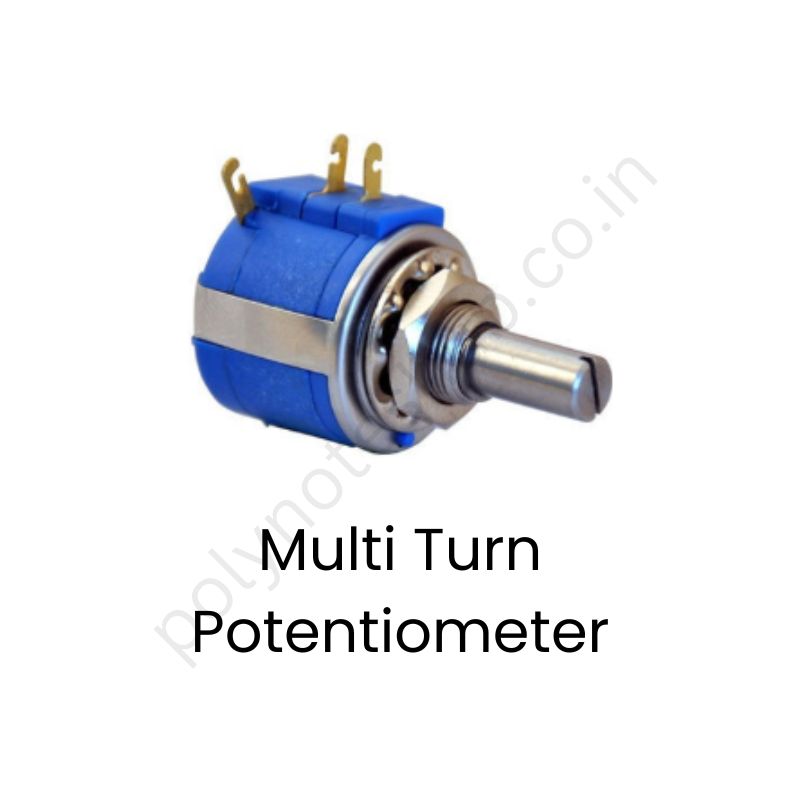
Applications of Multi-turn Potentiometer
- Used to calibrate the voltage and other parameters in instruments.
- Used in medical devices for sensitive tuning or adjustments.
- Used in industrial automation systems.
- Used in robotics to control electronics parameters.
- Also used in aerospace and defense types of devices.
3. Trim Potentiometer
A trim potentiometer (sometimes known as a trimpot) is a small, adjustable potentiometer used to tune or calibrate circuits on occasion. It is often installed on PCBs (printed circuit boards) and adjusted with a screwdriver during setup; it is not designed for frequent human engagement.
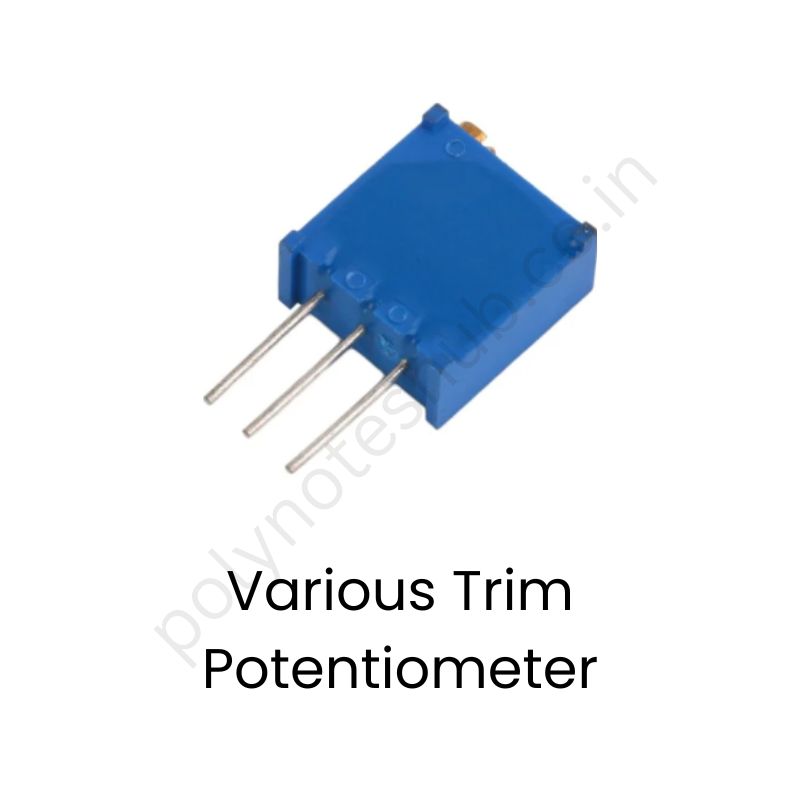
Applications of Trimmer Potentiometer
- Used in offset and gain adjustment in op-amp circuits
- Used to set reference voltages
- Used to display contrast control (e.g., LCDs)
- Audio tone and level settings
- Sensor calibration
4. Preset Potentiometer
A preset potentiometer is a small, adjustable resistor (similar to a trimpot) that is used to make internal modifications in an electrical circuit. It is usually set once during production or servicing and then left unmodified. Unlike standard potentiometers designed for frequent human involvement, a preset is modified with a screwdriver and put directly onto the PCB for internal calibration.
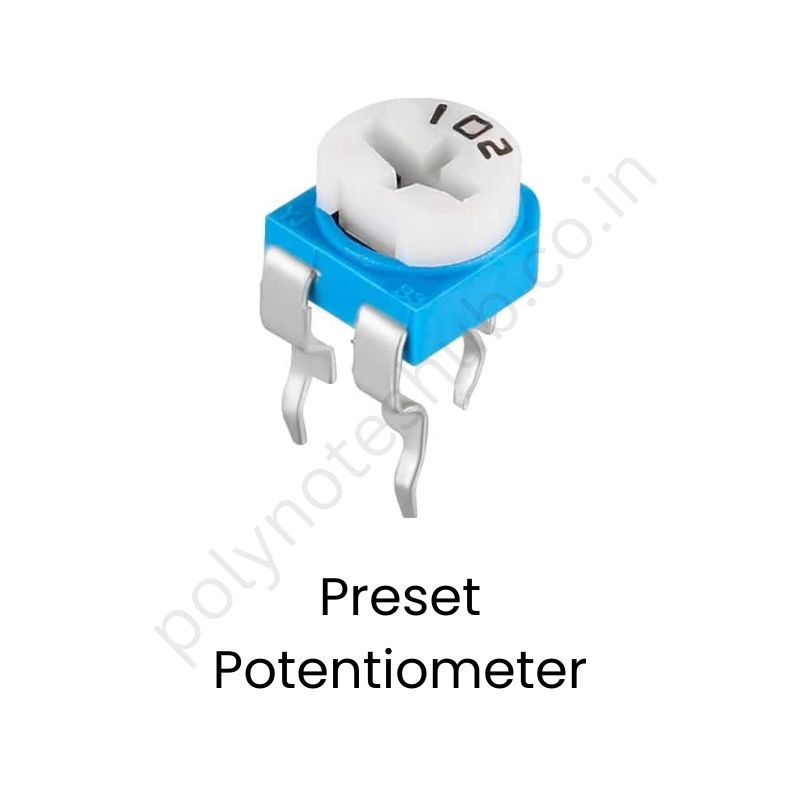
Applications of Preset Potentiometer
- Used in voltage and current calibration in power supplies
- Used for offset adjustment in operational amplifiers
- Used for control brightness in LCD displays
- Used to tune sensors in embedded systems
- Used to control frequency in oscillators
5. Slide Potentiometer or Slider Pot
A slide potentiometer, sometimes known as a slider pot, is a form of variable resistor that adjusts resistance by sliding a knob or lever along a straight path rather than spinning a shaft, as in rotary potentiometers. It includes a linear resistive strip and a sliding contact (wiper). Moving the slider alters the location of the wiper on the resistive circuit, hence altering the output voltage.
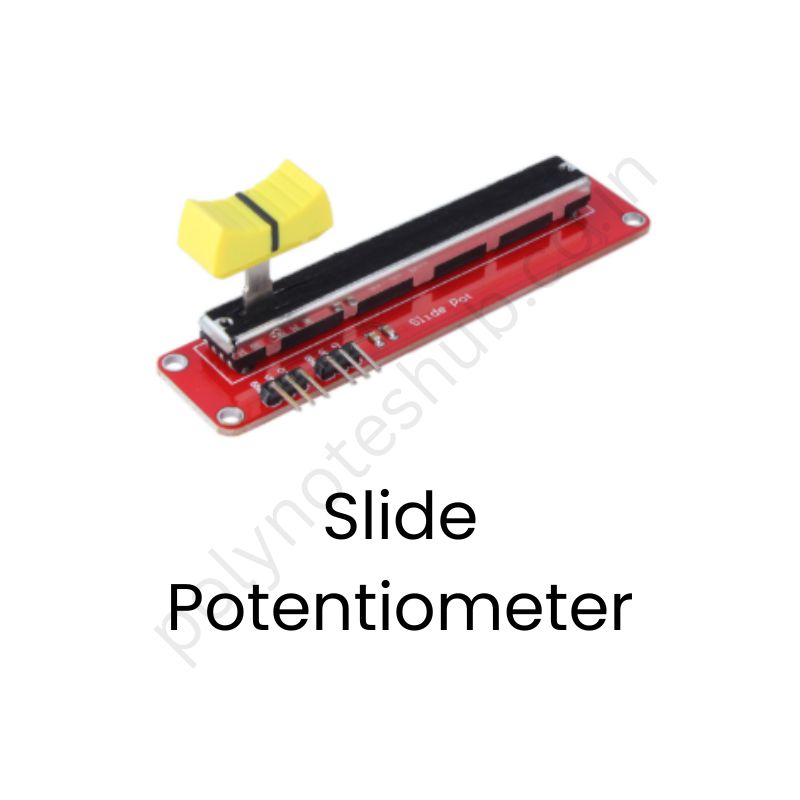
Applications of Slider Potentiometer
- Used as faders to control volume levels.
- Used for adjusting sound effects or modulation as well.
- Used in studio equipment to control input and output.
- Used in industrial control systems to do manual inputs.
- Used for intuitive control through sliding motion
6. Wire Wound Potentiometer
A wire wound potentiometer is a type of variable resistor in which the resistive element is formed by winding tiny resistance wire (such as nichrome) around an insulating core. It features a wiper that glides over the wire and turns to adjust the resistance. Because it uses actual wire rather than resistive film, it is noted for its excellent power handling, accuracy, and longevity, but due to inductance, it is often limited to low-frequency or direct current applications.
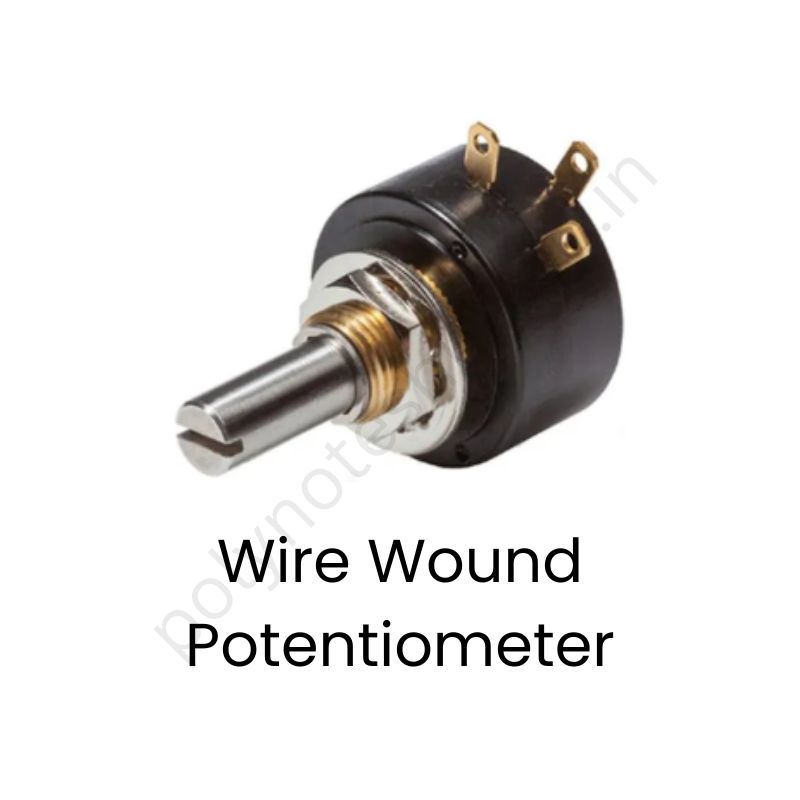
Applications of Wire Wound Potentiometer
- Used in power supply systems to control power input and output.
- Also used in heavy duty electric motors.
- Used in audio equipment for smooth and noise-free volume control.
- Used in robotics and mechatronics systems.
- Used in labs to do scientific experiments.
7. Dual Gang Potentiometer
A dual gang potentiometer is a type of potentiometer that houses two potentiometers connected by a single spinning shaft. Each “gang” has its own resistive track and wiper, allowing you to change two different signals simultaneously with a single turn. The term “gang” refers to the individual resistor sections within the component.
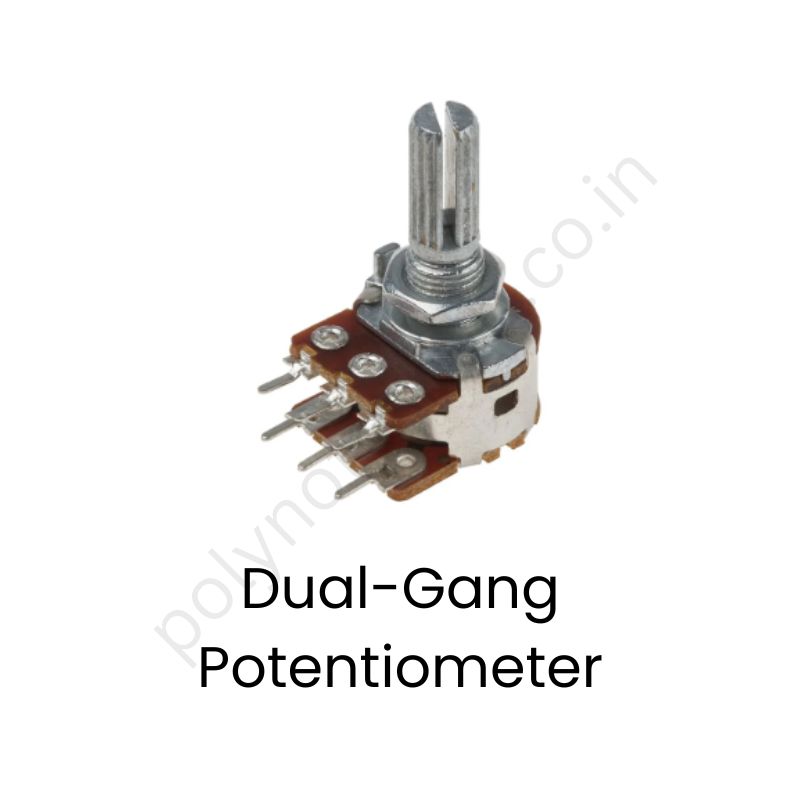
Applications of Gang Potentiometer
- Used in a stereo sound system to control the left and right audio channels.
- Used to control simultaneous bass/treble adjustment for both channels
- Used in mixing consoles for balanced fade or EQ adjustments.
8. Digital Potentiometer
A digital potentiometer (digipot) is an electronically controlled variable resistor that performs the same function as a traditional potentiometer. It is typically controlled digitally using signals, typically via protocols like I²C, SPI, or up/down pulses, rather than manually with a knob or slider. It is commonly employed in modern electronics when accuracy and remote control are critical.
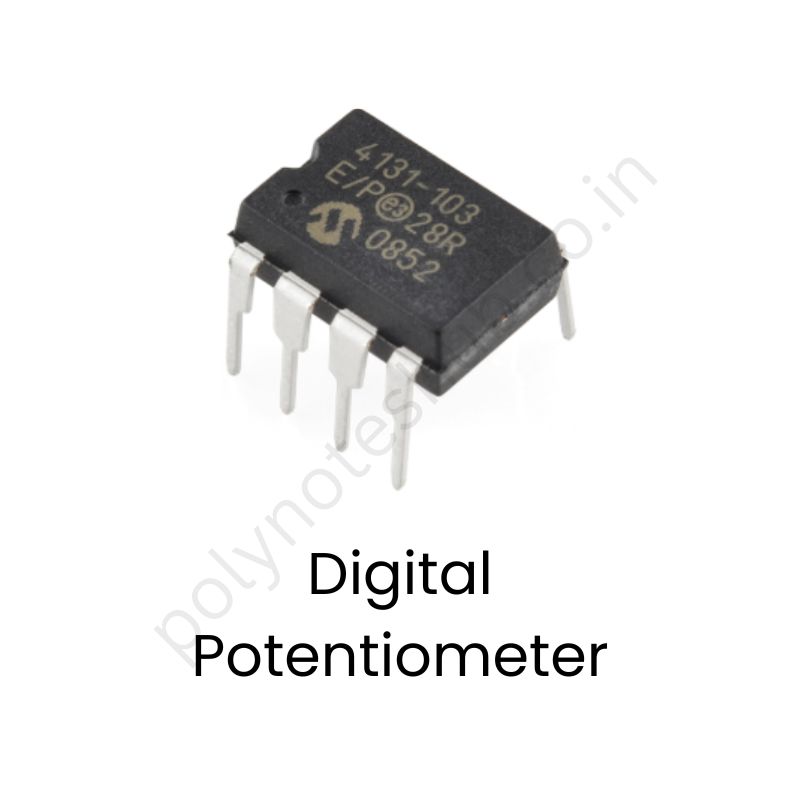
Applications of Digital Potentiometer
- Used in audio equipment to control voltage.
- Used in microcontroller projects.
- Used in power supply regulations.
- Used in consumer electronics equipment.
- Used in auto-tuning without manual access

